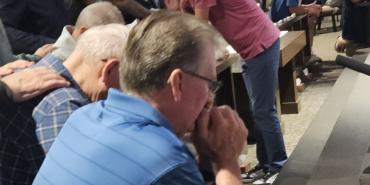The Habitat of Scripture

As someone raised in the Church of the Nazarene by committed Nazarene parents and grandparents, the Bible has always been central to my life and my faith. Growing up, I studied the Bible in my daily devotions, in Sunday school, in Bible quizzing, and in Vacation Bible School, just to name a few. Family game nights often were spent playing Bible trivia. The Bible was always something to be studied and learned.
It wasn’t until university that I began questioning this assumption. During a course on worship, I attended a non-evangelical church for the first time in my life. While observing the Divine Liturgy at a Greek Orthodox Church, I noticed that the congregation approached the Scriptures very differently than Nazarenes did.
At the beginning of worship, the Scriptures were brought solemnly into the church. At least three scriptural readings preceded the sermon, each one longer than what I was accustomed to hearing in my Nazarene context. It was a noticeable difference that planted a seed in my mind.
Several years later, the professor in a biblical studies class in seminary made a passing comment that caught my attention. He observed that churches in the catholic traditions—not Catholic tradition— give more weight to the Scriptures in their worship than those in the evangelical tradition.
I thought back to my experience in that Orthodox church. The seed began to sprout as I started to ask some hard questions. What I discovered shocked me.
The story that shapes us
Not only do the historic liturgies of the church include three Scripture readings while contemporary evangelical liturgies usually only include one, most of what is said and sung in the historic liturgies is taken directly from the Scriptures.
Last year during Bible Quiz season, my children studied the book of Ruth. One Sunday as my family ate lunch together, my son asked me, “Did you know that thing you say every week is the way Boaz greeted the harvesters?”
Our local congregation transitions from the sermon to our corporate response with me saying, “The Lord be with you.” The congregation responds, “And also with you.”
“That’s right,” I told my son. “The Bible isn’t just something we read and study. It is the story that shapes and forms us as the body of Christ.”
He had noticed something that had taken me several decades to figure out: worship, not the classroom, is the primary habitat of the Scriptures.
Sola Scriptura
What was new to me and my son, however, is nothing new to the church we confess in the historic creeds, of which we are a part. As Scott Hahn points out, “In the ancient world, the church’s liturgy—its public, ritual worship— was the natural and supernatural habitat of the church’s Scriptures” (Letter and Spirit, 9).
Going back even further, we see that this early Christian understanding of the relationship between worship and the Scriptures is received from the much older Jewish practice of public reading. For Jew and Christian alike, the Scriptures did not exist primarily to be studied and learned, but to be proclaimed in worship.
In that public proclamation, their primary purpose of witness and formation was fulfilled as the hearer was swept up into the story that was their story, which shaped them and formed them into God’s holy people.
To understand this idea, we need to revisit the Reformation idea of Sola Scriptura. Today this idea is commonly invoked to assert that the church has no authority except the Scriptures, pitting the Scriptures of the church against the tradition of the church. This, however, is not at all what the reformers meant by Sola Scriptura. In fact, it would be unthinkable to them.
The reformers’ understanding of Sola Scriptura was based on a synergistic relationship between the Scriptures and tradition. John Wesley, for instance, claims to be “a man of one book” (Standard Sermons), and our fourth article of faith is right to claim, “whatever is not contained [in the Scriptures] is not to be enjoined as an article of faith” (Church of the Nazarene Manual).
Scriptures are primary and enjoy a place of priority in the church, but the reformers also understood the dangers of any practice that allows the Scriptures to mean anything anyone interprets them to mean. Imagine the chaos that would ensue in the church—even in a local congregation—if the Scriptures were allowed to mean whatever any reader wanted them to mean.
The reformers understood there have to be boundaries and checks and balances in biblical interpretation. These safeguards are provided by tradition. The Scriptures then, while being primary, must be interpreted by and within the context of the tradition.
What is tradition?
The “Historical Statement” contained in our Manual notes specifically our “identification with the historic church in . . . its concern to raise up and maintain a ministry that is truly apostolic in faith and practice.” Here we get to the heart of the question of tradition. Tradition is that apostolic faith and practice we seek to maintain.
The apostolic faith is revealed to us and received by us through things like the ecumenical creeds, the decisions of the ecumenical councils, and the writings of the early church mothers and fathers. The apostolic practice is revealed to us and received by us through our participation in things like the historic hymnody, prayers, sacraments, and the calendar of the church. All of these things together constitute the apostolic faith and practice that is the tradition of the church.
Only one place exists in the life of the church where the Scriptures can be proclaimed, heard, interpreted, and applied alongside the creeds, the teachings of the early church, the singing of the hymns, the praying of the prayers, and the celebration of the sacraments. That place is in the worship—the liturgy— of the church.
The Bible is a liturgical book. It was written to be proclaimed in worship as a witness to the world and for the transformation of the church.
How we plan worship
For our clergy, this should be a primary factor in the way we plan and lead worship. We should ask about worship:
- Does it follow the Christian calendar?
- Is it saturated with Scripture?
- Does it follow historic orders and patterns?
- Is our preaching contextually relevant while being rooted in teachings of the early church mothers and fathers?
- Does our music express our apostolic faith?
- Is the proclamation and preaching of Scripture combined with frequent celebration of the Lord's Supper?
- How are you helping your people hear, interpret, and apply the Scriptures within the context of the tradition?
This should affect not only the way that we worship—expecting to hear, encounter, and be transformed by God in the proclamation and preaching of the Scriptures—but also the way we utilize the Scriptures in our personal devotional time.
- How does this time prepare you for worship?
- What other elements might you incorporate into your devotional moments? The creeds? The great historic hymns? The prayers and writings of the early church?
- How are you personally making sure that you hear, interpret, and apply the Scriptures within the context of the tradition?
Jude 3 reminds us to “contend for the faith that was once for all entrusted to God’s holy people.” We are that people, and we do that best when we allow the Scriptures to speak alongside the tradition within the habitat of our corporate worship.
Eric E. Frey is an ordained elder in the Church of the Nazarene serving congregations in Toronto and Stratton, Ohio.
Holiness Today, March/April 2017
Please note: This article was originally published in 2017. All facts, figures, and titles were accurate to the best of our knowledge at that time but may have since changed.




